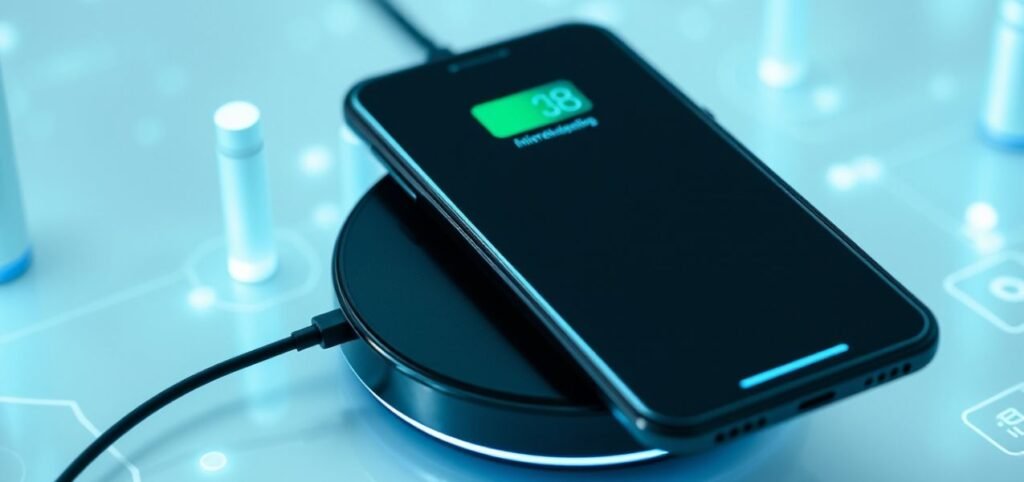In today’s tech-driven world, wireless chargers have become a convenient tool for charging devices without the need for cables. From smartphones to earbuds and even smartwatches, many modern gadgets now support wireless charging. This guide explains what wireless chargers are, how they work, and the benefits of using one.

What is a Wireless Charger?
A wireless charger is a device that allows you to charge your electronic gadgets without needing a charging cable to connect to your device. Instead of plugging a cable into your phone, for instance, you simply place it on a charging pad or stand, and it begins charging automatically. This is possible thanks to a technology called “inductive charging,” which transfers energy through electromagnetic fields.
How Do Wireless Chargers Work?
Wireless chargers work based on a principle called electromagnetic induction. This process involves two coils: one in the charger and one in your device. When you place your phone or other compatible device on the wireless charger, an electromagnetic field is created between the two coils. This field transfers energy from the charger to your device’s battery, causing it to charge.
Most wireless chargers today use a standard called Qi (pronounced “chee”), which has been widely adopted by major brands like Apple and Samsung. Qi-certified chargers are compatible with a variety of devices, meaning you don’t need a specific brand of wireless charger for each device as long as it supports Qi charging.
Types of Wireless Chargers
There are a few main types of wireless chargers, each offering unique features and designs:
- Charging Pads: These are flat and simple. You just place your device on the pad, and it begins charging. Charging pads are easy to use and are available in various sizes, so they’re great for desks or nightstands.
- Charging Stands: These allow you to place your phone upright, so you can still see the screen while it charges. Stands are often popular for people who want to continue using their phone while charging or want an easy view of notifications.
- Multi-Device Chargers: These chargers allow you to charge more than one device at once. For instance, you might charge your smartphone, smartwatch, and earbuds all on the same pad. These are convenient if you have multiple devices that support wireless charging.
Benefits of Using a Wireless Charger
Wireless chargers offer several benefits that make them a great addition to your daily routine:
- Convenience: With a wireless charger, you don’t have to deal with tangled cables or worry about wear and tear on charging ports. Just place your device on the pad, and it starts charging.
- Less Wear on Ports: Continuous plugging and unplugging can wear out the charging port on your device over time. Wireless charging eliminates the need for constant plugging in, which can extend the life of your device’s port.
- A Cleaner Look: A wireless charger helps reduce the number of cords cluttering up your space, giving your desk or nightstand a cleaner, more organized look.
- Universal Compatibility: With Qi wireless charging being so common, you can use one charger for multiple devices, making it easier to keep your gadgets charged without a lot of extra equipment.

Downsides of Wireless Charging
While wireless charging is convenient, there are a few downsides to consider:
- Slower Charging Speeds: Wireless chargers generally don’t charge as quickly as traditional cable chargers, especially when compared to fast-charging cables. This means it might take a bit longer to fully charge your device.
- Heat Generation: Wireless charging can generate more heat than wired charging, which might affect the efficiency of charging. Some chargers come with built-in cooling features, but heat can still be a concern with some models.
- Limited Mobility: With wireless charging, your device must stay on the pad or stand to charge. This means you can’t really use your device while it’s charging, unlike with a cable where you can move around a bit more freely.
Choosing the Right Wireless Charger
When choosing a wireless charger, here are a few things to consider:
- Charging Speed: Some wireless chargers offer faster charging than others. Look for chargers with a higher wattage if you want faster charging, though be aware that not all devices will support fast wireless charging
- Device Compatibility: Make sure the charger you choose is compatible with your device. Most modern chargers support the Qi standard, but it’s always a good idea to double-check.
- Design: Whether you prefer a flat pad, a stand, or a multi-device charger, choose a design that fits your needs. If you want to keep using your device while it charges, a stand might be best, whereas a pad could be ideal for a bedside setup.

Final Thoughts
Wireless chargers offer a hassle-free, organized way to keep your devices powered up. While they may be slower than traditional chargers and require you to keep the device on the pad, the convenience of simply placing your device down to charge can be a big plus. Whether you’re at work, home, or on the go, wireless chargers can fit seamlessly into your routine and make charging your devices easier than ever.

Pingback: 9 Gadgets for Your Home: Greatest Technology - Tech Passion
Pingback: Top 10 Best Wireless Keyboards for Gamers - Tech Passion